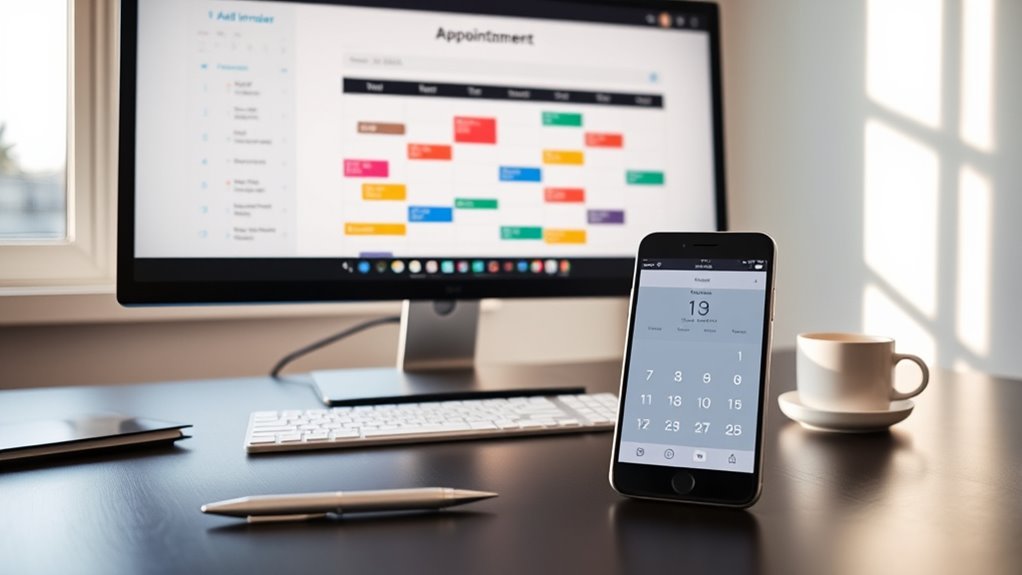An appointment scheduling system saves you time by combining real-time availability with automated reminders, reducing double bookings and last-minute cancellations. It allows clients to see open slots instantly, eliminating back-and-forth scheduling emails. Automation handles reminders and follow-ups, freeing you from manual tasks. This streamlines your workflow, enhances accuracy, and improves client satisfaction. Keep going to discover more ways these features work together to make your scheduling process hassle-free and efficient.
Key Takeaways
- Automated reminders reduce manual follow-up and decrease last-minute cancellations.
- Real-time availability displays current open slots for instant booking and reduces scheduling conflicts.
- Workflow automation streamlines appointment management, minimizing administrative tasks.
- Instant access to available times enhances customer experience and reduces communication delays.
- Compliance features ensure scheduling accuracy and legal adherence, saving time on corrections.

An appointment scheduling system is a vital tool that helps businesses and professionals manage their bookings efficiently. When you implement one, you gain access to features that streamline your entire scheduling process, saving you significant time and reducing no-shows. One of the key features you’ll appreciate is automated reminders. These reminders automatically notify your clients or patients about upcoming appointments through email or text messages. Not only does this cut down on last-minute cancellations, but it also reduces the need for manual follow-up, freeing you up to focus on other important tasks. Automated reminders ensure everyone stays informed, which minimizes the risk of missed appointments and keeps your schedule running smoothly.
Automated reminders reduce no-shows and save time by keeping clients informed about upcoming appointments.
Another essential feature is real-time availability. When your scheduling system shows your current open slots immediately, you eliminate the back-and-forth often involved in booking appointments. Clients or patients can see exactly when you’re available and book instantly, which speeds up the entire process. This real-time visibility means fewer double bookings or missed opportunities, and it provides a more seamless experience for your clients. With real-time availability, you can also make last-minute adjustments easily, updating your schedule on the fly to reflect cancellations or new openings. This flexibility ensures that your calendar is always accurate, saving time that would otherwise be spent managing conflicting appointments or correcting errors.
These features work together to optimize your scheduling workflow. Automated reminders eliminate the need for manual outreach, reducing administrative overhead and decreasing the chances of no-shows. The real-time availability feature ensures clients can book at their convenience while giving you full control over your calendar. When combined, they create a system that’s not only efficient but also reliable, making your day-to-day operations much smoother. You’ll spend less time on administrative tasks and more time focusing on your core responsibilities, whether that’s providing a service, running a business, or managing your team.
Furthermore, integrating these features into your scheduling system improves overall customer experience. Clients appreciate the convenience of seeing available slots instantly and receiving timely reminders, which can foster loyalty and positive reviews. The automation minimizes errors and miscommunications, making sure your schedule stays organized and accurate. Overall, these features aren’t just about saving time—they enhance professionalism and client satisfaction, leading to a more successful and stress-free operation. By leveraging automated reminders and real-time availability, you streamline your scheduling process, reduce stress, and ensure everything runs like clockwork.
Additionally, according to timing and dates standards, precise scheduling can help maintain compliance and ensure appointments are properly tracked for legal or operational purposes.
Frequently Asked Questions
How Secure Are Appointment Scheduling Systems Against Data Breaches?
Appointment scheduling systems are generally secure against data breaches when they use strong data encryption and user authentication measures. You should guarantee the system employs end-to-end encryption to protect your data during transmission and storage. Additionally, robust user authentication, like two-factor authentication, keeps unauthorized users out. By choosing a system with these security features, you can confidently safeguard your sensitive information and minimize the risk of data breaches.
Can These Systems Integrate With Existing Business Software?
You’ll find that many appointment scheduling systems seamlessly integrate with your existing business software, like CRM or calendar tools, thanks to their strong software compatibility. Coincidentally, this smooth integration often depends on addressing common challenges like compatibility issues or integration challenges, which can seem intimidating at first. But with the right support and clear setup instructions, you’ll easily connect these systems, streamlining your workflow without missing a beat.
Are Appointment Systems Suitable for Large Enterprises or Only Small Businesses?
Appointment systems are suitable for both large enterprises and small businesses. For large enterprises, choose scalable solutions that address scalability challenges, ensuring the system can handle high volumes of appointments and users. These enterprise solutions offer advanced features, integrations, and customization options. Small businesses benefit from simpler, cost-effective options. By selecting the right system, you streamline scheduling, improve efficiency, and support growth, regardless of your organization’s size.
How Customizable Are the Features of Appointment Scheduling Software?
You’ll find appointment scheduling software offers impressive feature flexibility, allowing you to tailor the system to your needs. User personalization is key, so you can customize appointment types, notifications, and availability. Many platforms let you adjust settings easily, ensuring your scheduling process aligns with your workflow. This high level of customization helps you save time and enhances your clients’ experience, making the system a versatile tool for any business size.
What Is the Typical Cost Range for Implementing Such a System?
You’ll find that pricing variability for appointment scheduling systems can range from free basic plans to $50 or more per user monthly for advanced features. Implementation expenses may include setup fees, customization, and staff training, which can add a few hundred to several thousand dollars depending on your needs. Budget accordingly, and compare options to find a solution that fits your business size and desired features without overspending.
Conclusion
Implementing an efficient appointment scheduling system can save you time and reduce no-shows. Did you know that automated reminders decrease no-show rates by up to 20%? By leveraging features like real-time availability and automated confirmations, you streamline your workflow and improve customer satisfaction. Investing in the right system isn’t just a convenience; it’s a smart move that boosts productivity and keeps your schedule running smoothly. Don’t wait—upgrade today to see these benefits firsthand.









